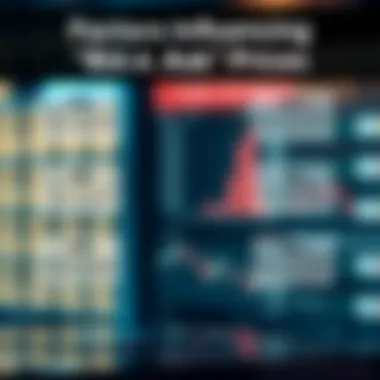Understanding Bid and Ask Prices in Financial Markets


Intro
In the bustling world of financial markets, grasping the underlying principles of trading is essential for anyone wanting to make informed decisions. Two key terms that emerge in nearly every trading conversation are bid price and ask price. Understanding these concepts not only aids in everyday trading but also sets the foundation for more advanced financial strategies.
The bid price refers to the highest price a buyer is willing to pay for a particular asset. Conversely, the ask price is the lowest price a seller will accept. This interplay between buyer and seller creates a dynamic relationship that impacts market liquidity and forms the basis upon which trades are executed.
It's vital to comprehend how these prices fluctuate in reaction to market conditions, supply and demand, and economic indicators. As we delve deeper into this article, we will unpack the significance of these concepts, their implications for various market participants, and practical strategies traders can use to navigate these nuances effectively.
Investment Terminology Basics
Key Terms Explained
To really appreciate the nuances of bid and ask prices, one must first be familiar with a few key terms:
- Spread: The difference between the bid price and the ask price. A narrower spread generally indicates a more liquid market.
- Market Order: An order to buy or sell immediately at the current market prices, influenced directly by bid and ask.
- Limit Order: An order to buy or sell at a specific price or better. This is where knowing the bid and ask prices can give traders an advantage.
- Liquidity: Refers to how easily assets can be bought or sold in the market without affecting the asset’s price.
These terms not only frame the discussion around bid and ask prices, but also give context to the various strategies traders might employ.
Common Investment Strategies
Understanding the dynamics of bid and ask prices leads to several critical investment strategies:
- Arbitrage: This involves exploiting price differences between markets. By buying at a lower ask price in one market and selling at a higher bid in another, traders can make profits without taking on risk.
- Market Making: This strategy involves placing both buy and sell limit orders to capture the spread as profit. Market makers play a significant role in providing liquidity to the markets.
- Swing Trading: Traders using this strategy often place trades based on predicted short-term price movements, evaluating the bid-ask spread to determine entry and exit points.
- Scalping: This is a high-frequency trading strategy focusing on small price gaps and quick trades. Bid and ask prices are critical to scalping success, as timing is everything.
- Hedging: In hedging, traders use put options and other derivatives to protect against adverse price movements. Understanding bid and ask prices can influence how reallocation occurs during price shifts.
The strategies outlined above highlight how crucial bid and ask prices are in making educated trading choices.
"Price is what you pay. Value is what you get." - Warren Buffett
This quote serves as a gentle reminder that the bid and ask prices are just the starting point in understanding the true value of investments.
Navigating through financial markets necessitates more than just knowing what bid and ask means. It's about appreciating how various factors can influence these prices and the strategies that best use this knowledge to improve trading outcomes. In the next section, we will delve deeper into real-world applications of bid and ask prices, providing insights to enhance your market strategies.
Intro to Bid and Ask Prices
In the realm of financial markets, understanding bid price and ask price is crucial for anyone looking to navigate the complex waters of trading and investment. These terms often come up in discussions about stock exchanges, forex, and beyond, serving as the foundation of market activities.
At their core, bid and ask prices represent offers to buy and sell assets, respectively. Grasping these definitions isn't just about memorizing terms; it's about comprehending how these prices interact to form the much-discussed concept of market equilibrium. A solid understanding of these prices can immensely influence trading strategies and investment decisions.
Learning the differences between these two prices helps investors gauge the market's health and the liquidity of their assets.
Consider a situation where you're looking to invest in a popular stock. You glance at the market data and notice the bid price is considerably lower than the ask price. This disparity could be a red flag, indicating potential volatility or low interest in the stock, which directly affects your buy and sell execution.
Examining bid and ask prices also sheds light on investor behavior. Many investors employ this knowledge to identify entry and exit points for their trades. By analyzing the spread and making informed decisions based on it, traders can enhance their chances of maximizing profits or minimizing losses.
Benefits and Considerations
- Market Navigation: Understanding these prices allows for more informed trading and strategic planning.
- Investment Timing: Knowledge of bid and ask prices can dictate when to enter or exit positions, maximizing profits.
- Market Sentiment Insight: Price disparities can indicate larger market trends and investor confidence.
However, it’s essential to remember that focusing solely on these prices without considering other market factors can lead to a skewed perspective. External elements like market news and economic indicators play a role in the fluctuation of bid and ask prices, further complicating the picture.
"The bid and ask prices are the first indicators of a market's pulse; overlooking them could mean missing out on great opportunities."
As we dive deeper through the discussions around defining bid and ask prices, we will uncover not only what they are but also how they shape the essence of financial trading. Understanding these concepts is the first step toward becoming a savvy investor.
The Concept of a Spread
In many cases, the spread serves as a barometer of market conditions. A tight spread may indicate high liquidity, where numerous buyers and sellers are vying for an asset, while a wider spread may signal a less active market, potentially leading to larger costs incurred during trading. Recognizing how the spread reacts to market volatility can offer insights into whether it’s the right time to buy or sell.
Understanding Bid-Ask Spread
The bid-ask spread can be viewed as a small window into the marketplace's heart. It’s constructed from two pivotal prices: the bid price, which reflects the maximum price that a buyer is willing to pay for an asset, and the ask price, which denotes the minimum price at which a seller is willing to part with it. This spread is not just a number; it reveals valuable information about market conditions.
The size of the bid-ask spread can change based on various factors. It tends to narrow during times of heightened trading activity—such as market openings or significant news events—when many participants are active. Conversely, in situations where trading slows, the spread tends to widen as fewer buyers and sellers are present, causing a disparity in price acceptance.


For example, imagine stocks trading in a bustling market like the New York Stock Exchange. A stock may show a bid price of $100 and an ask price of $100.50, resulting in a spread of $0.50. However, during after-hours trading when activity diminishes, the same stock might show a bid price of $99.50 and an ask price of $101, leading to a spread of $1.50. Such variations highlight the importance of considering the spread when planning trading strategies.
Importance of the Spread
The spread holds significant implications for both novice and seasoned traders alike.
- Transaction Costs: The spread essentially represents a cost that traders must navigate. The larger the spread, the greater the implicit costs when executing trades. Understanding this can help traders factor in their potential profits and losses more accurately.
- Market Sentiment and Efficiency: A consistently narrow spread might indicate a healthy trading environment where buyer confidence is robust. On the other hand, a wider spread can suggest uncertainty or a lack of common ground between buyers and sellers.
- Trading Strategies: Some trading strategies hinge directly on spread analysis. For instance, traders might employ techniques such as scalping, where they make numerous small profits on minor price changes. Here, understanding spreads can be crucial for determining entry and exit points.
In short, the spread is much more than just a number representing the margin between buying and selling prices; it provides insights into market liquidity, costs, and even trader psychology. For anyone engaged in trading, grasping the spread's significance can transform their approach to managing investments.
"A trader's ability to read the spread can distinguish a successful trader from one simply guessing at market movements."
The nuances of the bid-ask spread play an essential role in the overarching dynamics of trading, effectively shaping decision-making and strategic planning in the complex world of financial markets.
Market Dynamics Behind Bid and Ask Prices
The interplay between bid and ask prices is a critical piece of the puzzle when it comes to understanding market behavior. These prices act as the heartbeat of financial markets, signaling where buyers and sellers stand relative to one another. Without a grasp of the factors that influence these prices, investors risk making poorly informed decisions that can lead to significant losses.
This section delves into the various elements that shape bid and ask prices, providing readers with valuable insights into their dynamics. Understanding these nuances can greatly enhance one's trading strategy and overall market acumen.
Factors Influencing Bid Price
Bid prices are influenced by a variety of factors that reflect the willingness of buyers to purchase at a given price. Here are several key elements that play a role:
- Market Demand: When more buyers are interested in acquiring a security, the bid price tends to rise. High demand can lead to aggressive bidding, thereby increasing the price limit at which a buyer is willing to purchase.
- Liquidity of the Asset: The more liquid an asset is, the more likely it is that there will be many bids at various price points. In illiquid markets, bid prices may fluctuate more wildly due to fewer buyers and sellers.
- Information Flow: Reports, news, and economic indicators can impact investor sentiment. Positive forecasts may boost demand, leading to higher bids, while negative news can bring prices down.
- Investor Sentiment: Psychological factors also play a role. If investors feel optimistic about a stock, they may be willing to bid higher than they normally would. Conversely, fear can suppress the bid price.
- Competition Among Buyers: If multiple buyers are vying for the same asset, competition can push the bid price up. This almost auction-like scenario showcases the competitive dynamics at play in the market.
One must keep an eye on these influences, as they can shift swiftly. As an investor, recognizing these factors can provide a competitive edge in predicting price movements.
Factors Influencing Ask Price
Understanding the ask price requires a look at the other side of the marketplace equation. Several dynamics influence how sellers set their ask prices:
- Supply Levels: If there is an oversupply of an asset, sellers might lower their ask prices to attract buyers. The greater the number of available options, the more likely sellers will feel pressure to adjust their prices downward.
- Market Sentiment: A seller's sense of market direction can significantly influence the ask price. If the sentiment is bullish, a seller may keep their ask price higher, anticipating future price increases.
- Time Sensitivity: Some sellers might be motivated to sell quickly, influencing them to set a lower ask price to facilitate a rapid transaction. This necessity often leads to a price that undercuts the typical market valuation.
- Cost of Carry: For certain assets like commodities, holding costs (storage, insurance, etc.) can lead to higher ask prices. Sellers may factor these costs into their pricing to ensure they preserve margins.
- Brokerage Fees and Commissions: For trades involving brokers, the fees might influence ask prices, as sellers may set their prices higher to encompass the transaction costs, aiming to protect their profitability.
Understanding these factors allows investors to better interpret price movements and the rationale behind them. This understanding can also promote strategic decision-making regarding entry and exit points in their investment strategies.
"In financial markets, knowledge is power. Understanding the forces shaping bid and ask prices can determine your success or failure in trading."
Recognizing these dynamics in bid and ask prices isn’t just for the seasoned trader; even novice investors can benefit from understanding these foundational elements as they navigate the complexities of the market.
For further insight into these concepts, resources such as investopedia.com, investing.com, and marketwatch.com offer extensive information and analysis.
Bid and Ask Prices in Different Markets
In the realm of financial trading, bid and ask prices serve as the backbone of market dynamics. Each market—be it stocks, forex, or cryptocurrencies—has its own nuances influencing these prices. Understanding how bid and ask prices operate in these varied settings is vital for any trader or investor aiming to make informed decisions. This section explores how the unique characteristics of each market shape the way bid and ask prices are determined and what implications they hold.
Stock Markets
In stock markets, the interplay between bid and ask prices is paramount. The bid price represents what buyers are willing to pay for shares, while the ask price is what sellers want for them. This essential relationship reveals much about market liquidity and sentiment.
- Liquidity: Stocks with higher trading volumes typically exhibit narrower spreads, indicating more buyers and sellers in the market. Conversely, illiquid stocks can have significantly wider spreads, as fewer participants lead to inconsistent pricing.
- Market Conditions: Economic indicators, earnings reports, and geopolitical events can affect the bid and ask prices dramatically. For instance, an unexpected earnings miss may cause sellers to pull their ask prices higher, leading to volatility.
The stock market often serves as a barometer of economic health, and the bid-ask dynamics observe and react to larger trends long before they hit mainstream media.
Forex Markets
When it comes to forex markets, bid and ask prices are from different perspectives. The forex market deals with currency pairs, and the bid price signifies the amount a trader will pay for a currency, while the ask price indicates what a trader must pay to acquire it.
- Market Hours: Unlike stock markets, forex operates 24 hours a day, which means bid and ask prices can fluctuate sharply based on real-time news and events around the globe.
- Currency Fluctuations: Political instability or changes in interest rates can lead to quick shifts in bid and ask prices. For instance, news of an interest rate hike often strengthens a currency, compelling tighter spreads as traders flock to buy.
Understanding these nuances in the forex sector is essential for traders because a slight difference in the spread can significantly impact profits when leveraged positions are involved.
Cryptocurrency Markets


Cryptocurrency markets display some of the most dynamic bid and ask price movements, influenced by a cocktail of trading volume, market sentiment, and infrastructure.
- Volatility: Cryptocurrencies are notorious for their price swings. A tweet from a high-profile figure or developments in regulation can result in drastic adjustments to bid and ask prices in mere minutes.
- Market Maturity: As the crypto market matures, the bid-ask spread has tightened compared to its early days. This evolution can lead to increased liquidity, attracting more traditional investors. However, market manipulation remains a concern, as the sheer nature of some smaller cryptocurrencies can lead to erratic pricing.
To successfully engage in trading, one must grasp not just the numbers on a screen but the market's pulse beneath them.
For further readings on order types and their impacts, visit:
By mastering these essential concepts of bid and ask prices across different markets, investors can lay a solid foundation for developing effective trading strategies.
Real-World Applications of Bid and Ask Prices
The concepts of bid and ask prices play a crucial role in the functioning of various financial markets. Understanding their real-world applications not only enhances one’s trading skills but also aids in making informed investment decisions. This section will delve into the execution of trades, the differences between market orders and limit orders, and how these prices impact overall trading strategies.
Execution of Trades
When traders decide to buy or sell an asset, they often rely on the bid and ask prices to complete their transactions. The bid price represents the maximum price that a buyer is willing to pay for an asset, while the ask price denotes the minimum price that a seller will accept. In practice, these prices are not merely numbers; they signal the supply and demand dynamics present in the market.
——
"In stock trading, the real-time changes of bid and ask prices can often dictate a trader's success or failure." ——
When executing a trade, timing is everything. An investor may submit a market order, where they agree to buy or sell immediately at the prevailing market prices. This strategy can be quite effective in a fast-moving market, where prices fluctuate significantly within moments. However, the risk of slippage exists. Slippage occurs when the execution price differs from the expected price, often due to the rapid sensitivity of bid and ask prices.
Alternatively, traders may opt for limit orders, setting a specific price at which they are willing to buy or sell. This approach provides more control but comes with the potential downside of not executing if the market does not reach the designated price.
Market Orders vs. Limit Orders
Understanding the distinction between market orders and limit orders is essential for any trader.
- Market Orders: These are executed at the best available price in the current market. Traders utilize market orders when they prioritize speed and want to ensure that their trade goes through regardless of slight price variations.
- Limit Orders: In contrast, these orders are only executed at a specific price or better. This allows the trader to exercise more control over the trade but can lead to missed opportunities if the asset never reaches the set price.
Each type of order reflects the trader's risk tolerance and market outlook. A savvy trader might use a mix of both in their strategy to balance execution speed and price control.
Impact on Trading Strategies
Bid and ask prices can greatly influence trading strategies. One popular strategy includes "scalping," where traders aim to profit from small price changes. Scalpers pay close attention to the bid-ask spread and execute numerous trades throughout the day. By capitalizing on minute fluctuations between the bid and ask prices, traders can accumulate substantial gains, albeit often with small margins.
Another strategy involves using technical indicators and historical bid-ask data to predict market movements. Investors analyze trends and patterns in bid and ask prices, helping to refine their entry and exit points and enhancing their ability to forecast future price shifts.
Understanding liquidity is also important; assets with a small bid-ask spread generally indicate a liquid market. This means that traders can buy and sell more efficiently, minimizing their costs associated with trading.
In summary, incorporating an understanding of bid and ask prices into trading practices transforms one’s approach and enhances success in the market. The grasp of these real-world applications equips traders with the tools needed to navigate complex financial waters with confidence.
Bid and Ask Prices: Psychological Aspects
In the world of trading, understanding the psychological underpinnings behind bid and ask prices is imperative. This section delves into the intangible yet powerful influences that trader behavior and market sentiment exert on these prices.
Trader Behavior
The decisions traders make are often influenced by more than just data and statistics; emotions play a significant role. Traders respond to market movements not only based on facts but also feelings. For instance, fear and greed are two emotions that are frequently discussed in trading psychology. When prices fall, fear often grips traders, leading them to sell at lower prices than they anticipated. Conversely, when prices rise, the excitement of potential profits can drive them to push ask prices upward as they seek to capitalize on market momentum.
Moreover, traders often engage in herd behavior, which is the tendency to follow what others are doing. This can amplify fluctuations in bid and ask prices as traders rush to act on perceived trends. For instance, if a high-profile investor sells a large quantity of shares, other traders may rush to follow suit, causing bid prices to drop significantly. This creates a domino effect where each successive trade further influences the market.
On a practical level, understanding these behavioral biases can give traders an edge. By recognizing the emotional states that can affect decision-making, they can hedge against poor choices driven by fear or euphoria. Thus, monitoring not just the numerical data but the psychological climate can offer insights that lead to more strategic trading.
"In trading, it's not just about numbers; understanding psychology can be the difference between profit and loss."
Market Sentiment


Market sentiment encapsulates the collective mood of traders, which can significantly impact bid and ask prices. Often characterized as bullish or bearish, sentiment reflects whether traders are optimistic or pessimistic about a particular market or asset.
The interplay between sentiment and bid-ask dynamics can be quite pronounced. For instance, during a bullish sentiment phase, ask prices may inflate as sellers anticipate higher future prices. Conversely, in a bearish market phase, bid prices may drop as buyers are hesitant, unsure about the direction of price movement.
Several factors can influence market sentiment, like economic news, geopolitical events, or even social media trends. Positive earnings reports can uplift a stock’s sentiment, leading to an increase in ask prices as traders believe the stock will continue to rise. Alternatively, negative news can create an atmosphere of panic, pushing bids down as traders seek to exit their positions, often at a loss.
Investors who can gauge market sentiment effectively may position themselves advantageously. Utilizing indicators such as the Fear and Greed Index can be enlightening for discerning the overall market mentality. Understanding sentiments enables better predictions of bid-ask movements, allowing traders to make more informed decisions rather than relying solely on historical data.
Analyzing Bid and Ask Data
In today's fast-paced financial markets, analyzing bid and ask data is not just an add-on; it’s a pivotal aspect of trading decision-making. Understanding how to interpret this data can lead to significant advantages, whether you are a seasoned investor or a novice trader. The core of effective trading lies in knowing how to leverage bid and ask prices to gauge market dynamics, making this analysis indispensable.
Reading Order Books
Order books are the lifeblood of any trading platform, showing all buy and sell orders for a particular asset at any given moment. This transparency offers a granular view of market activity and reveals the true depth behind bid and ask prices.
- What to Look For: A trader should pay attention to various elements within an order book. For instance, you can see the volume of orders at each price level. Higher volumes indicate stronger market interest and can act as indicators of support or resistance levels.
- Example in Practice: Imagine you’re looking at the order book for the technology stock XYZ Corp. If you notice large buy orders (bids) sitting just below the current market price, it might suggest that there’s a safety net for the price if it dips. On the flip side, substantial sell orders (asks) above the market price might indicate resistance, where upward price movement is likely to stall.
"Understanding order books is akin to reading the pulse of the market; ignoring this vital resource is like stepping into a boxing ring blindfolded."
- Benefits of Analysis: By regularly analyzing order books, traders can fine-tune their strategies based on real-time data rather than relying on historical trends alone. This helps in making split-second decisions that could minimize losses or maximize profits.
Using Technical Indicators
Technical indicators are essential tools that enhance the analysis of bid and ask data. They don't provide the complete picture, but they help illuminate it, guiding traders in their decisions.
- Common Indicators: Traders often employ indicators such as Moving Averages, Relative Strength Index (RSI), and Bollinger Bands. Each serves to analyze price levels in conjunction with bid and ask prices, helping to identify trends and potential reversal points.
- Practical Application: Suppose a trader notices that the moving average of a security is below its current ask price, indicating that the asset is overbought. This could signal a potential sell opportunity before the price corrects. Recognizing these signals early gives traders a considerable edge.
- Limitations to Note: While technical indicators offer valuable insights, relying solely on them can lead to pitfalls. It's crucial to combine this data with a broader understanding of market conditions, including news events or earnings reports, that could impact bid and ask prices.
By grasping how to read order books and effectively use technical indicators, traders can make informed, strategic choices, enhancing their understanding of bid and ask dynamics.
Risks Associated with Bid and Ask Prices
Navigating the world of financial markets isn't merely about savvy investments; it's also about understanding the risks inherent to trading. This section zeroes in on the risks associated with bid and ask prices, as these factors can significantly influence trading outcomes. Recognizing these risks arms investors and traders with knowledge to make better decisions, secure their capital, and craft effective trading strategies.
Understanding Slippage
Slippage refers to the difference between the expected price of a trade and the actual price at which the trade is executed. It often occurs during periods of high volatility or low liquidity, making it a critical risk for traders to grasp. For instance, in fast-moving markets like cryptocurrencies or during economic announcements, an investor may set a buy or sell order expecting it to execute at a specific price, only to discover that the execution happens at a less favorable price due to rapid changes in the market.
Slippage can manifest in two forms:
- Positive Slippage: This occurs when a trade executes at a better price than anticipated; for instance, placing a sell order at $100 but having it execute at $102.
- Negative Slippage: Conversely, this is when a trade executes at a worse price than expected, such as placing a buy order at $100 but executing at $98.
Understanding slippage is vital because it can erode profits quickly in high-frequency trading environments. Investors should use limit orders instead of market orders to mitigate this risk wherever possible. However, understanding that slippage is often out of a trader's control shows the unpredictable nature of the market, and it's prudent to prepare for it as a part of a comprehensive risk management strategy.
Mitigating Risks
Mitigating risks associated with bid and ask prices requires a multifaceted approach. Here are a few strategies that can help:
- Use Limit Orders: By employing limit orders, traders can specify the exact price they are willing to accept, reducing the chance of slippage. Unlike market orders that execute immediately at the best available price, limit orders get executed only at the set price or better, adding a layer of control.
- Monitor Market Conditions: Staying informed about market conditions is crucial. Economic news, company earnings reports, and geopolitical events can impact bid and ask prices significantly. Traders should be aware of these factors to time their trades better and minimize exposure to slippage.
- Implement Stop-Loss Orders: A stop-loss order automatically sells an asset when it reaches a predetermined price, limiting potential losses. This is especially useful in volatile markets where price movements can be sharp and unpredictable.
- Diversify Investments: By spreading investments across various asset classes or markets, the risk reduces. This strategy softens the blow if a particular asset experiences slippage during a trade.
- Choose a Reputable Broker: Not all brokers handle orders with the same efficiency. Selecting a broker with a reputation for speed and reliability can make a difference in the execution of trades and the risk associated with bid and ask prices.
"Understanding the nuances of bid and ask prices is essential for investors seeking to protect their assets."
Closure
The discussion surrounding bid price and ask price forms a cornerstone in the realm of financial transactions. In this article, we’ve traversed through the intricate dynamics of these prices, illustrating their pivotal role in shaping market behavior and informing trader strategies. Understanding the bid-ask relationship is not merely an academic exercise; it holds real-world implications that can influence investment decisions and trading outcomes.
Summary of Key Insights
Understanding bid and ask prices ultimately boils down to several key insights:
- Market Mechanics: Bid price and ask price are essential to comprehend market efficiency. The gap between these prices, known as the spread, can vary based on numerous factors, including market volatility and trading volume.
- Market Behavior: Traders’ psychology also plays a role. High volatility can lead to wider spreads as buyers and sellers adjust their prices according to perceived risk and uncertainty.
- Practical Applications: Knowing how to read these prices is a practical skill. Investments often hinge on executing trades at the right price, be it through market or limit orders. Understanding where bid and ask prices lie helps in making timely and informed decisions.
Overall, insights garnered from this article underline that having a sound grasp of bid and ask prices can significantly boost one’s chances of success in trading activities. It is not just about knowing the numbers; it’s about understanding their implications within various market contexts.
The Path Forward
As we look toward the future, several considerations come to mind for traders and investors alike.
- Continuous Learning: Markets are ever-evolving. Staying updated on economic news, regulatory changes, and market sentiment is crucial. This proactive approach can lead to better strategic positioning.
- Leverage Technology: Various platforms provide bid-ask data in real-time, but it’s essential to choose tools that deliver accuracy and reliability. Familiarizing oneself with trading platforms that incorporate analytical features will also enhance decision-making.
- Risk Management: Always remember that with opportunities come risks. Employing strategies to manage slippage, understanding one's risk appetite, and practicing discipline can help mitigate financial losses.















